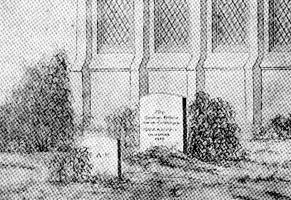∞∞∞∞∞∞∞

Pencil sketch of Poe’ lost tombstone, by Charles H. Dimmock.
This pencil sketch by Charles H. Dimmock is all that remains of the headstone Poe’s cousin Neilson ordered from Hugh Sisson in 1860. Hugh Sisson’s account of the destruction of the stone is as follows: “That tablet was finished and standing in my yard. It was to be erected in the cemetery the following week, and would have been but [for] a most extraordinary accident on the Friday or Saturday preceding. My yard adjoins the tracks of the Northern Central Railroad. A freight-train ran off the track, broke down the fence, and did more or less damage to other work; but the only irreparable damage was done to Poe’s tablet. That was smashed to pieces, beyond all power of restoration” (quoted by Thomas Dimmock in “Notes on Poe,” Century Magazine, June 1895, pp. 315-316, reprinted in Pouder, “Poe of Baltimore,” Baltimore Magazine, September 1949, p. 20).
The three-foot high, white Italian marble tablet was inscribed with the following epitaph: “Hic Tandem Felicis Conduntur Reliquae. Edgar Allan Poe, Obiit Oct. VII 1849.” (This epitaph has been translated as “Here, at last, he is happy. Edgar Allan Poe, died Oct. 7, 1849.”) The reverse side of the stone read “Jam parce sepulto” (translated as “Spare these remains”).
As the stones had not yet been placed over Poe’s grave, the setting for the sketch is fanciful. In no way does it indicate the location of Poe’s place of burial.
∞∞∞∞∞∞∞
[S:1 - JAS] - Edgar Allan Poe Society of Baltimore - Baltimore - Poe's Memorial Grave - Poe’s Lost Tombstone